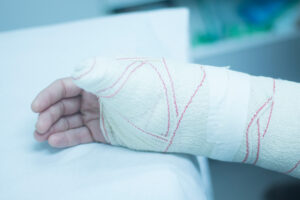When you go to A&E (Accident and Emergency), the farthest thing from your mind is the possibility of receiving substandard medical care. Unfortunately, poor medical care does happen in hospitals, with serious repercussions for the patients affected by it. No matter what kind of A&E negligence you’ve experienced, please keep reading to find out whether you may have a case to claim compensation.
Essential Information
- Accident and Emergency departments are essential for triaging patients.
- According to NHS statistics, 26.2 million people attended A&E in 2023/24.
- Negligent A&E care could involve inadequate examinations or a failure to refer patients for tests or scans.
- Medical negligence claims can pay out compensation for someone’s pain and suffering, together with any associated financial loss.
- You can make a No Win No Fee claim with a solicitor from our panel, no matter where you live in the country.
Contact our friendly and experienced team of advisors today to see if you have a valid accident and emergency claim. You can get started with the process and receive a completely free initial consultation by:
- Calling 0113 460 1216.
- Starting a conversation via live chat.
- Using our online form.

Jump To A Section
- Can I Claim For A&E Negligence?
- How Much Compensation Can Be Awarded In A&E Negligence Claims?
- What Are Some Examples Of A And E Negligence?
- How Long Is The Time Limit For A And E Negligence Claims?
- What Accident And Emergency Negligence Claims Evidence Will I Need?
- Can I Make A No Win No Fee A&E Negligence Compensation Claim?
- Why Choose Our Panel Of Solicitors To Claim For A&E Medical Negligence
- Learn More
Can I Claim For A&E Negligence?
You can claim for A&E negligence if your case meets specific conditions:
- A medical professional or hospital owed you a duty of care.
- That duty of care was breached in some way.
- Due to the breach, you suffered harm that was avoidable or otherwise unnecessary.
A duty of care refers to the obligation that all medical professionals and facilities have to their patients. Simply put, it requires them to provide a level of care which meets the minimum expected standard. This might include listening to the patient, ordering further tests where necessary, and carrying out the appropriate treatment.
If standards are not met, causing unnecessary harm, then there may be grounds to claim. However, it’s important to keep in mind that not every instance of harm will be avoidable. Sometimes, harm happens, even when, say, accident and emergency staff provide the correct level of care to a patient. Later on in this guide, you will get more context on what may constitute medical negligence.
Can I Make A Claim Against The Ambulance Staff Or Paramedic?
If your case meets the conditions set out above, you can make a claim against ambulance or paramedic staff. They would owe you the same duty of care as their patient that other healthcare and medical professionals must meet. If they fail to meet that obligation, causing unnecessary harm, then you may be able to claim compensation.
Can I Pursue An A&E Negligence Claim On Behalf Of A Loved One?
In certain circumstances, you can pursue an A&E negligence claim on behalf of a loved one by being a litigation friend. This means you will represent your loved one by communicating and making decisions for them. Litigation friends are used in situations where a claimant is mentally incapacitated or under 18, as neither can independently pursue compensation.
If you want to know more about anything else covered in this section, including how a duty of care might apply to your specific situation, please reach out to an advisor.

How Much Compensation Can Be Awarded In A&E Negligence Claims?
In A&E negligence claims featuring very severe brain damage, individuals may receive £344,150 to £493,000. This compensation range is suggested by the Judicial College Guidelines (JCG), a document that publishes suggestive brackets for various forms of harm. This harm is covered under a head of claim referred to as general damages, which solicitors may assess using the JCG.
You can see more brackets below, all taken from the JCG apart from the initial entry. Since they are only suggestive, please keep in mind that you should use the table only for guidance.
| Harm | Severity | JCG Brackets | Notes |
|---|---|---|---|
| Multiple Very Severe Forms of Harm + Special Damages | Very Severe | Up to £1,000,000+ | Together with multiple very severe forms of harm, there will be financial impact, such as care costs. |
| Brain | Very Severe | £344,150 to £493,000 | Compensation in bracket considers factors such as life expectancy, degree of insight (should there be any), impairment of senses, and capacity to communicate. |
| Chest | Removal of a Lung and/or Serious Heart Damage (a) | £122,850 to £183,190 | In worst kind of case, there will be serious, prolonged pain and suffering, together with permanent and significant scarring. |
| Traumatic (b) | £80,240 to £122,850 | Impacting chest, heart, and/or lung(s), resulting in permanent damage, function impairment, reduced life expectancy, and physical disability. | |
| Back | Severe (i) | £111,150 to £196,450 | Damage to spinal cord and nerve roots. This will result in severe pain and disability, together with issues like significant impairment of bowel, bladder, and sexual function. |
| Severe (ii) | £90,510 to £107,910 | Damage to nerve roots with loss of sensation and unsightly scarring, amongst other issues. | |
| Bowel | b) - Total loss of Natural Function | Up to £183,190 | Claimant will have reliance on colostomy, depending on age. |
| Knee | Severe (i) | £85,100 to £117,410 | Disruption of the joint and development of osteoarthritis, along with lengthy treatment and other issues. |
| Ankle | Very Severe | £61,090 to £85,070 | Includes extensive soft-tissue damage from transmalleolar fracture, causing deformity and the risk that a future leg injury would require a below-knee amputation. |
| Wrist | Loss of Function (a) | £58,710 to £73,050 | This loss will be complete, such as cases involving an arthrodesis. |
What Else Can Be Covered By A&E Negligence Compensation?
A&E negligence compensation can also cover your financial losses, which can be claimed for via special damages. These losses must have resulted from the unnecessary harm you suffered from. Provided that is the case, you could claim for:
- Loss of income, inclusive of future impact on earnings.
- Care costs, both from professionals and family.
- Medical expenses, which could range from private treatments for reconstructive surgery to ongoing prescriptions.
- Mobility aids or other assistive equipment, such as a wheelchair or voice-activated technology.
- Adaptations to your car or home. Severe injuries may impact mobility or lead to a disability, which could require walk-in baths, stairlifts, or the installation of grab rails.
You will require bank statements, receipts, invoices, or other documentation in order to claim for any financial losses.
Who Is Responsible For Paying My Compensation?
If your claim is successful, NHS Resolution would be responsible for paying out A&E compensation. As an arm’s length body of the Department of Health and Social Care, NHS Resolution manages claims on behalf of relevant NHS trusts. It uses its own funding for compensation payouts, meaning there will be no impact on public healthcare services.
Questions about how compensation is calculated and what other losses could be claimed for under special damages? Then, please contact our advisors for guidance tailored to your unique circumstances.
What Are Some Examples Of A And E Negligence?
You will find some examples of A&E negligence below, showing how it can occur and why it might lead to a valid compensation claim. However, it’s important to highlight that your experience of negligent care in an emergency environment might be different:
- A patient presents at A&E with symptoms of a heart attack but is sent home without being adequately checked over. The patient later requires emergency surgery to remove a blockage and is left with ongoing coronary problems due to the delayed diagnosis.
- A patient fractures their wrist while playing football. However, the triage staff do not refer them for tests, leading to the fracture being missed. This failure affects the healing process, leaving them with long-term agility issues.
- A&E staff confuse the tell-tale symptoms of sepsis for a chest infection and send a patient home with antibiotics. The patient later needs to have their toe amputated as the sepsis spreads fast due to the initial negligent care.
- Hospital staff at A&E misread a patient’s medical records, leading them to be given a prescription for a medication to which they have a known allergy. This leads the patient to suffer a severe reaction that causes permanent organ damage.
- A doctor mixes up a patient’s X-ray scan for someone else’s, resulting in the patient being discharged despite having a break in their bone. The doctor had instead concluded they had a sprain.
All emergency claims are different, so please reach out if you are unsure about whether you experienced negligence.
How Long Is The Time Limit For A And E Negligence Claims?
The time limit for starting accident and emergency negligence claims is 3 years, per the Limitation Act 1980. This begins either:
- On the date negligence happened.
- On the date you were aware negligence happened (the ‘date of knowledge’).
While this time limit applies in most cases of medical negligence, there are 2 instances when it doesn’t:
- When claimants are under 18: Minors cannot pursue medical negligence claims themselves, and no time limit applies until they come of age. Therefore, the 3-year time limit only begins from their 18th birthday.
- When claimants do not have the mental capacity to claim independently of someone else: No time limit will take effect unless capacity is regained, at which point the 3 years will be counted from the date of recovery.
During the pause on time limits, litigation friends may help get claims underway earlier. You can refer to our earlier section for further details or contact one of our advisors. They can also help determine whether you’re still within the time limit to claim.

What Accident And Emergency Negligence Claims Evidence Will I Need?
For accident and emergency negligence claims, you will need evidence like medical records showing how you suffered unnecessarily because of substandard medical care. Claims for medical negligence benefit from a strong body of evidence, which can include:
- Details of anyone who could provide a solicitor with an eyewitness statement.
- Your full medical records documenting your triage experience, any diagnoses (or misdiagnoses), and treatments.
- An independent medical assessment – this will be arranged by your solicitor if necessary.
If you’re worried about the process of proving a claim, please reach out. Our advisors are ready to help and can explain how one of the solicitors from our panel could assist with obtaining evidence to support your case.
Can I Make A No Win No Fee A&E Negligence Compensation Claim?
Yes, you can make a No Win No Fee A&E negligence compensation claim with an expert solicitor from our panel. They will offer a contract called a Conditional Fee Agreement, which aims to take the potential strain out of hiring a solicitor. That’s because claiming under a Conditional Fee Agreement ensures:
- You will not pay a single solicitor’s fee to get started with claiming.
- You won’t be charged any solicitor’s fee while pursuing the claim itself.
- There are no solicitor fees to pay if the claim is lost.
Under a CFA, you would only need to pay a success fee if you get compensation. This would be payment for all the work done on your case and comes out of the compensation. However, the percentage taken is capped by legislation.
Want to know more about No Win No Fee claims? Please reach out via your chosen contact method.
Why Choose Our Panel Of Solicitors To Claim For A&E Medical Negligence
By choosing our panel of solicitors to claim for A&E medical negligence, you will gain access to a tailored, nationwide service. When claiming, you want to feel supported and not overwhelmed by the process. Our panel of medical negligence solicitors firmly believe that this should be the case for all their clients, which is why they offer support like the following:
- Negotiate the best compensation settlement for you, ensuring it fairly reflects your pain and suffering.
- Collect witness statements and other evidence on your behalf.
- Arrange an independent medical assessment to prove the extent of harm you’ve suffered.
- Connect you with specialists in various fields, such as psychiatrists or physiotherapists.
- Speak to all parties involved in the claim so you can stay focused on your recovery.
Contact Medical Negligence Claims Care
Speak to our team of advisors to see if emergency negligence claims could be the right path for you. From the moment you reach out, you’ll know you’ve made the right choice to work with one of the specialist solicitors from our expert panel. Your initial consultation is completely free and there is no obligation to proceed, so why not reach out to our advisors today by:
- Calling 0113 460 1216.
- Starting a conversation via live chat.
- Using our online form.

Learn More
Find out more information regarding medical negligence in some of our other guides.
- Find out how long medical negligence claims take to conclude.
- Discover the average payout for fatal medical negligence claims.
- See how to claim for unnecessary surgery.
We’ve also included some external links related to A&E negligence.
- Read about the symptoms of sepsis via NHS.UK.
- Discover the symptoms of a heart attack via NHS.UK.
- Find out what a medical professional’s duty of candour is via the General Medical Council.
We hope you found our guide on A&E negligence useful, but please get in contact for more tailored guidance.

